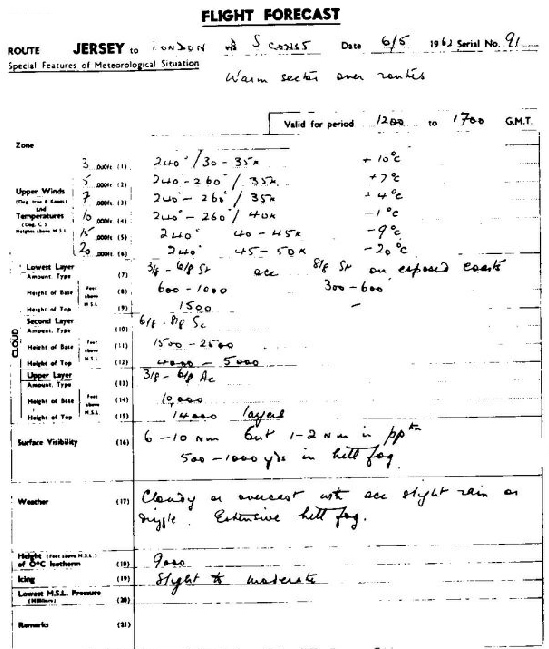

The Weather
The weather on 6th May could be divided into two sections.
Over England, dense fog had grounded the airlines for several days and after a holiday period which had seen a lot of outward traffic, there was great pressure to get everyone home again.
The South Coast was still seriously affected by fog and low cloud, but across the Channel the weather was glorious, Jersey and Guernsey basking in full sun. Thus the moment it seemed possible to get planes in the air to bring home stranded passengers, the pressure was on.
Flying outward from Southend the weather had little effect as the aircraft were above the cloud, although as we shall see an attempt was made to land at Portsmouth. This was aborted as conditions were too bad and visibility appalling, but out over the Channel the weather changed to give near perfect flying conditions.
On the return trip when approaching the English coast, there was a real possibility
of meeting a wall of cloud above 300 feet, but the forecast visibility would then
give between 5 -
A professional aviation forecaster has reviewed the data for us and commented that
the visibility provided for the return flight was much too optimistic for the actual
conditions that day and that he would have given a very much lower distance, but
he also thinks the crew would have been aware of this issue. The forecast they received
stated 50% cloud at 600 feet and a minimum of 1000 yards visibility ( this seems
a contradiction in hill fog ? ), However a lookout on a Trinity House ship near Ventnor
couldn’t see the front of the ship from the bridge -
The weather forecast provided to the crew.
WEATHER FORECAST
Valid 1200 hrs to 1700 hrs
3/8 -
Possibility of complete cloud cover on exposed coasts
Surface visibility 6 -
Extensive hill fog
Visibility 500 -
Wind Westerly 15 -
At the time weather in the Portsmouth region was given (and later confirmed) as
3/8 cloud at 100 feet
Full cloud cover at 300 feet.
Visibility was still well outside the acceptable -
Even in 1962 it seems incredible that there was no radio at the airport which would have enabled the aircraft to call the field and ask about conditions. Not knowing what visibility was like, the only way to determine if they could land was to drop down to the minimum safe height and see if they could firstly find the airfield, and secondly see enough to land on the grass runway. If there had been radio communication this could have been done from above the cloud in complete safety with a short radio call, but instead they had to go and have a look. In the prevailing conditions and without modern electronic aids, it would be almost impossible to find the airfield with a standard approach ( although the other aircraft on the run did manage this ) and the only safe way in low visibility was to let down below the cloud before reaching land and flying under ‘visual flight rules’. This was basically looking out of the window, keeping the sea and eventually the coast in sight at all times and then flying along the coastline reading the map. If the weather had been as forecast this could have been done without too much trauma although today it would have been completely unacceptable for a commercial aircraft. That is presumably what the crew were planning to do.
Thus if the weather had been as forecast, and with a low level flight round the coast, it might have been possible to land at Portsmouth, although why any professional pilot with passengers would want to try this in the conditions is something we will look at later on.
What remains a mystery is why nobody on the ground in Jersey thought to phone up
and ask someone at Portsmouth to look out of the window ..… but perhaps, just perhaps,
that might have scuppered any chance of getting the passengers back to their correct
destination. Perhaps in the ‘press on regardless’ world of the independent airlines
in the early 1960’s decisions like this were left to the flight crew -

| Instruments |
| Visibility |
| Navigation |
| An Alternative Theory |
| Pressure On Crews |
| Blame |